Adirondack Mosses
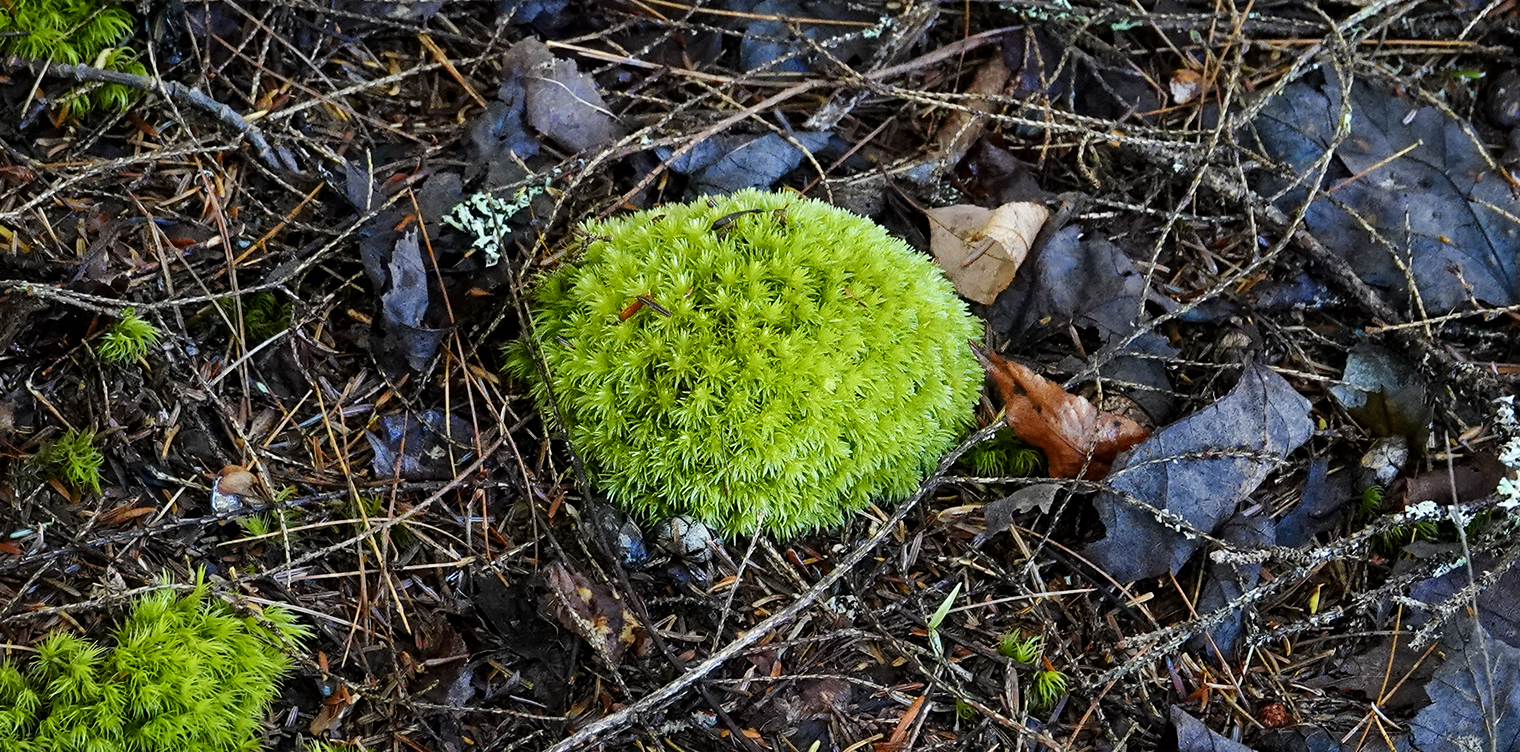
Mosses are small plants that typically grow close together in clumps or mats, often in damp or shady locations. They evolved about 500 million years ago. Like other land plants, mosses contain green chlorophyll and make their own food through photosynthesis, which involves using the energy of the sun to combine carbon dioxide and water to make sugars. Mosses differ from plants like wildflowers and trees in several ways:
- Wildflowers and trees are vascular plants, which means that they that have lignified tissues (the xylem) for conducting water and minerals throughout the plant. They also have a specialized non-lignified tissue (the phloem) to conduct products of photosynthesis. This feature allows vascular plants to evolve to larger sizes.
- Mosses are nonvascular plants, which means that they lack a vascular system. Because nonvascular plants lack lignified water-conducting tissues, they can't become as tall as most vascular plants.
Where Do Mosses Grow?
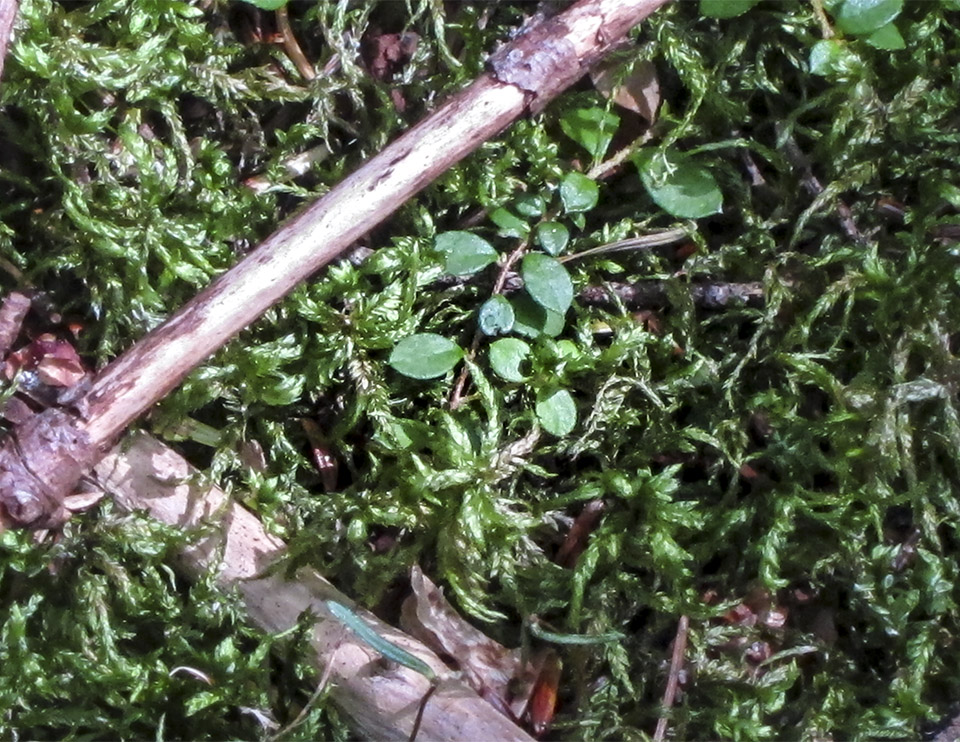
Mosses grow on a variety of substrates (the surface or material on or from which an organism lives, grows, or obtains its nourishment).
- Some mosses can be found on the forest floor. Examples include Common Haircap Moss (Polytrichum commune), which flourishes on the forest floor of hardwood and mixed wood forests; Spiky Peat Moss (Sphagnum squarrosum) which grows on the floor of nutrient-rich, wet conifer forests; and Schreber's Big Red Stem Moss (Pleurozium schreberi), which flourishes on the forest floor of conifer-dominated forests.
- Other mosses can be found on boulders, such as Juniper Haircap Moss (Polytrichum junperinum), which also grows on ledges.
- Some mosses grow on tree bark, such as Ulota Moss (Ulota crispa).
- Many mosses flourish on rotten logs and stumps. An example is the Pincushion Moss (Leucobryum glaucum), which also grows on the forest floor.
- Still other mosses are largely confined to wetland areas, such as the Sphagnum species which dominate Adirondack bogs, providing a thick carpet of vegetation on which other plant life flourishes.
What Mosses are Not
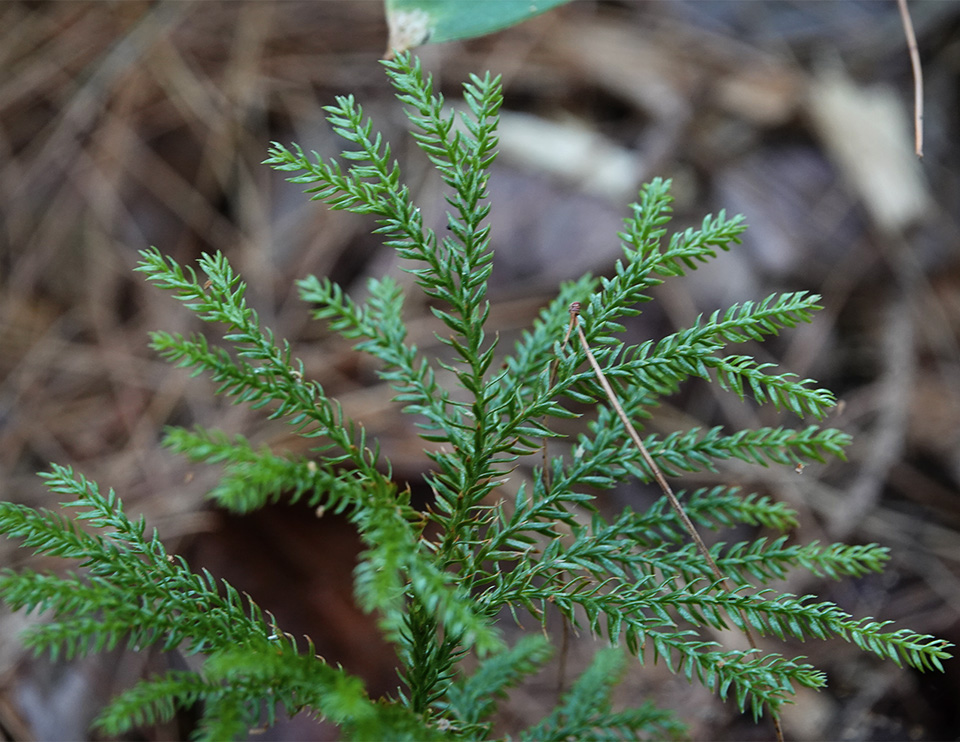
Mosses are commonly confused with several other plant-like life forms, which are not mosses.
Lichens: Some lichens (which are technically not plants but composites of a fungus and an alga or cyanobacterium) may be mistaken for moss. An example is Reindeer Moss, which forms an attractive light-colored mat on the forest floor.
Clubmosses: Despite the name, clubmosses (which resemble either diminutive relatives of conifers or giant mosses) are not mosses at all. They are vascular plants (thought at one time to be related to ferns) and have supporting structures, like stems and roots, that mosses do not. Examples include Princess Pine (Lycopodium obscurum) and Shining Clubmoss (Lycopodium lucidulum).
Liverworts: Like mosses, liverworts are small, green nonvascular plants. Some liverworts look like flattened green ribbons. However, leafy species of liverworts may look very much like moss. An example is Bazzania trilobata, a big leafy liverwort common in moist forests in the Adirondacks.
The Ecological Roles of Mosses
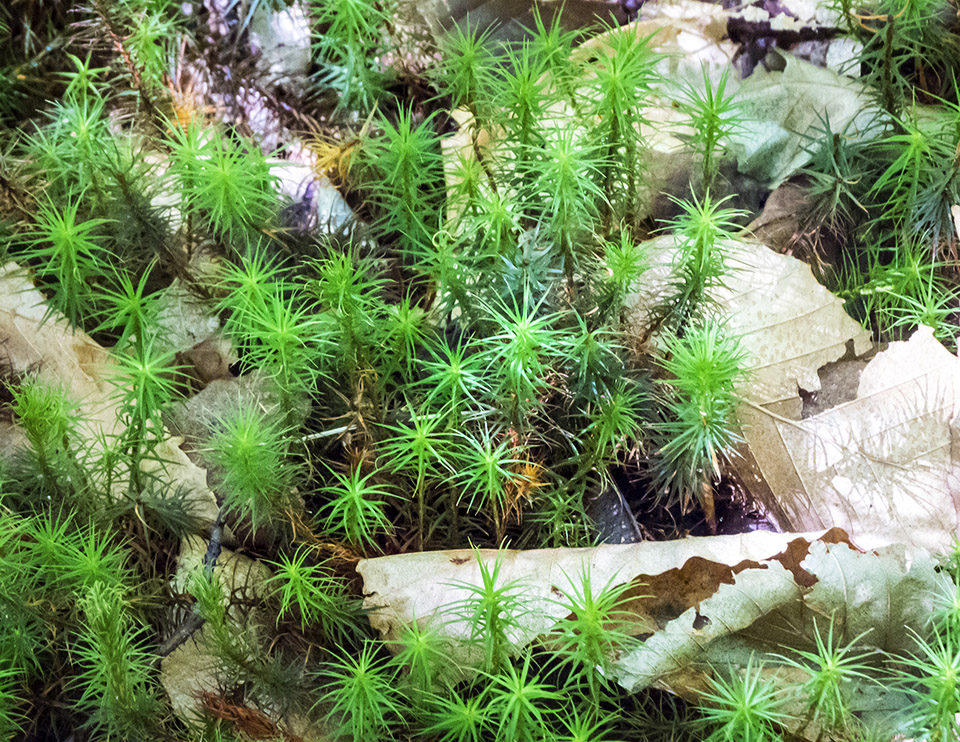
Mosses play essential roles in the natural world:
- Mosses don't need previously developed soil to survive, because they obtain their mineral nutrients from rain or running water. This means that mosses are sometimes the first to colonize newly exposed areas. They promote soil formation, because (as they grow) dust and humus collects among the stems. When they die, their bodies decompose and add to the developing soil.
- Mosses grow where other plants cannot, because they can survive without being rooted in soil. They can survive on cliffs, rocks, steep hills, and tree trunks. Mosses colonize the barren rocks and exposed areas of hills, and make them suitable for growing larger vascular plants by depositing humus soil and plant debris. Mosses can remain alive even during periods of drought, resuming photosynthesis when moistened again by rain or even fog.
- Mosses play an important role in the global carbon cycle. They absorb carbon dioxide and release oxygen. In areas with cool climates, such as the Adirondacks, decomposition is slow because of cold temperatures. This means that large amounts of carbon are sequestered in the Sphagnum of bogs.
- Mosses also contribute to the environment by absorbing water from rainfall and runoff, then slowly releasing it to the ground or atmosphere. This reduces stream erosion and fluctuating lake levels.
- Mosses also provide habitat on which many species ultimately depend, underpinning entire ecosystems. Mosses provide shelter for other organisms such as small insects. The insects, in turn, provide food for frogs, which in turn provide food for snakes, which in turn provide food for carnivores like bobcats.
Some Common Mosses of the Adirondacks
Some Common Mosses of the Adirondack Park
- Common Haircap Moss (Polytrichum commune)
- Juniper Haircap Moss (Polytrichum juniperinum)
- Pincushion Moss (Leucobryum glaucum)
- Schreber's Big Red Stem Moss (Pleurozium schreberi)
- Sphagnum (Sphagnum sp)
- Stair-step Moss (Hylocomium splendens)
- Ulota Moss (Ulota crispa)
Although a comprehensive listing of the mosses that flourish in the Adirondack Park could not be found, a rough estimate can be derived from the 1980 list of mosses cataloged in Edwin Ketchledge's monograph: Revised Checklist of Mosses of New York State. The checklist is organized into 26 districts whose boundaries do not coincide with the boundaries of the Adirondack Park. However, an estimate of the Adirondack species can be obtained by focusing on those species recorded for the four districts which encompass most of the Adirondack region (3, 4, 10, 11). This yields an estimate of 404 moss species in the Adirondack region.
Common Haircap Moss (Polytrichum commune) is one of the most abundant and widespread mosses that botanizers will encounter along Adirondack trails. It occurs throughout the Adirondack Park. It grows in a variety of habitats, including boreal and mixed forests, and a variety of substrates, including the forest floor, ledges, and boulders. This moss is dark green to brownish with age and grows in usually dense, tall tufts. Common Haircap Moss looks like tiny pine tree seedlings growing in thick patches. This species reportedly gets its name from the hairs that cover, or cap, the calyptra where each spore case is held. Another theory is that the name derives from the use of the plant to brew a tea said to be effective as a rinse to strengthen hair.
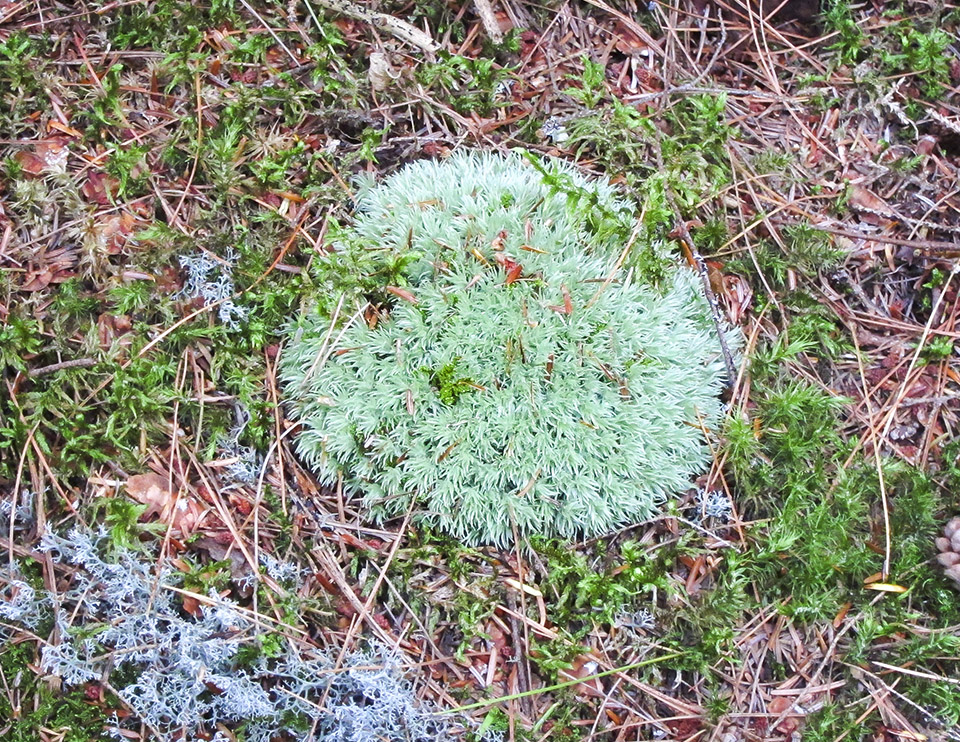
Pincushion Moss (Leucobryum glaucum) is another native moss frequently encountered in the Adirondacks. As the name implies, it forms very dense, usually round, cushions on the group, forming an attractive grayish green cushion. Pincushion Moss grows in a variety of habitats, including boreal, mixed wood, deciduous forests, and wooded swamps. It can be found growing on a variety of substrates, including the forest floor, boulders, banks, and old rotted and collapsed stumps and logs.
Another common northern forest moss is Ulota Moss (Ulota crispa), also known as Crispy Tuft Moss and Curled Brittle Moss. This moss grows on tree trunks, where it forms dense, rounded mounds of dull, dark olive green. It has been documented throughout most of New York State, including the Adirondack region.
Stair-step Moss (Hylocomium splendens) flourishes on the forest floor in both coniferous and hardwood forests. Also known as Splendid Feather Moss, this species grows on soil, humus, decaying wood (such as rotten logs), and rocks, and is abundant in northern boreal forests. It is generally olive or yellowish green, with reddish stems. Its common name comes from the fact that each year's growth forms a flat, horizontal spray arising from the back of the previous year's growth, forming an ascending series of stairs. This moss usually occurs in the later stages of succession. One of the most common northern forest mosses, Stair-step Moss has been documented in most regions in eastern New York State, including the Adirondack Park.
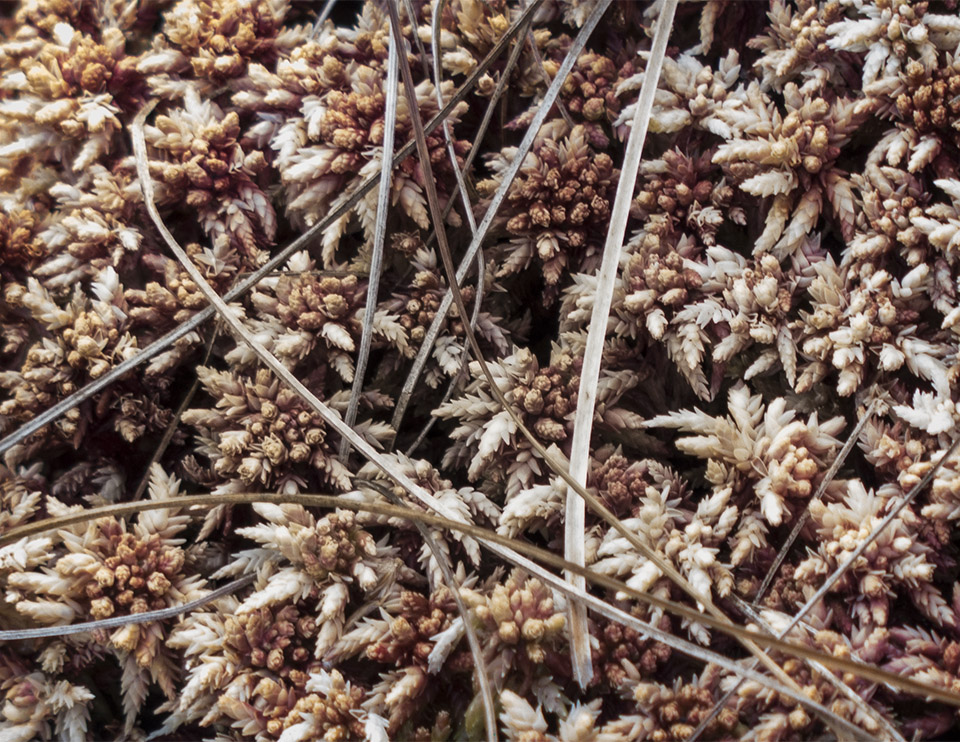
Sphagnum plays a critical role in the formation of Adirondack bogs. Sphagnum's ecological significance is based on its ability to increase acidity, creating the acid environments characteristic of bogs. There are a reportedly 380 species in this genus, which is commonly known as peat moss. Andrus' 1980 catalogue of sphagnum species within New York State, revised in 1994, lists a total of fifty species in New York State, including 39 in the Adirondacks.
Virtually all species prefer a wet habitat, occurring at different levels with respect to the water table. Some species are adapted to growing submersed in or at water level; others are found on the sides or tops of hummocks. As a result, one bog may contain a number of species, each adapted to varying distances from the water table.
The first Sphagnum species to colonize a new aquatic habitat are species which are able to grow submerged. As Sphagnum accumulates, species which flourish in slightly drier sites take over. Succession continues with the spread of species, like Sphagnum fuscum, which is adapted to growing on hummocks. Sphagnum decays very slowly. As a result, it accumulates in large quantities, acidifying the environment and providing habitat for bog-dwelling wildflowers and shrubs, as well as the few tree species (like Black Spruce and Tamarack) that are able to grow in this nutrient-poor environment.
References
Edwin H. Ketchledge. Revised Checklist of the Mosses of New York State (University of the State of New York, 1980. Retrieved 12 February 2017.
Northern Forest Atlas. Images. Retrieved 15 November 2021.
Jerry Jenkins and Sue Williams. Mosses of the Northern Forest – A Digital Atlas (The Northern Forest Atlas Project, April 2020). Retrieved 14 November 2021.
Flora of North America. Retrieved 12 February 2017.
USDA. Natural Resources Conservation Service. The Plants Database. Retrieved 12 February 2017.
Karl B McKnight. Common Mosses of the Northeast and Appalachians (Princeton University Press, 2013).
Ralph Pope. Mosses, Liverworts, and Hornworts. A Field Guide to Common Bryophytes of the Northeast (Cornell University Press, 2016).
University of British Columbia. Introduction to Bryophytes. Retrieved 12 February 2017.
Lakehead University. Faculty of Natural Resources Management. Boreal Forest Website. Retrieved 12 February 2017.
Ellen Rathbone, "Lycopodium – The Moss That Isn’t," Adirondack Almanack, 30 September 2009.
Joe Rankin, "Lichens: Not Technically A Plant," Adirondack Almanack, 16 February 2016.
Paul Hetzler, "Lichens: More Than Meets The Eye," Adirondack Almanack, 3 November 2015.
Robin Wall Kimmerer. Gathering Moss. A Natural and Cultural History of Mosses (Oregon State University Press, 2003).
Common Haircap Moss
Edwin H. Ketchledge. Revised Checklist of the Mosses of New York State (University of the State of New York, 1980), p. 15. Retrieved 12 February 2017.
Northern Forest Atlas. Polytrichum commune. Retrieved 15 November 2021.
Jerry Jenkins and Sue Williams. Mosses of the Northern Forest – A Digital Atlas (The Northern Forest Atlas Project, April 2020), pp. 765-771. Retrieved 14 November 2021.
USDA. The Plants Database. Polytrichum Moss (Polytrichum commune). Retrieved 12 February 2017.
Karl B McKnight et al. Common Mosses of the Northeast and Appalachians (Princeton University Press, 2013), pp. 56-57.
Flora of North America. Polytrichum commune Hedwig. Retrieved 13 February 2017.
University of British Columbia. Introduction to Bryophytes. Polytrichum commune. Retrieved 14 February 2017.
Lakehead University. Faculty of Natural Resources Management. Polytrichum commune. Common Hair Cap. Retrieved 12 February 2017.
Ohio Moss & Lichen Association. Polytrichum commune. Common Haircap Moss Retrieved 15 February 2017.
Juniper Haircap Moss
Edwin H. Ketchledge. Revised Checklist of the Mosses of New York State (University of the State of New York, 1980), p. 15. Retrieved 12 February 2017.
Northern Forest Atlas. Polytrichum juniperinum. Retrieved 15 November 2021.
Jerry Jenkins and Sue Williams. Mosses of the Northern Forest – A Digital Atlas (The Northern Forest Atlas Project, April 2020), pp. 772-775. Retrieved 14 November 2021.
USDA. The Plants Database. Juniper Polytrichum Moss. Polytrichum juniperinum Hedw. Retrieved 13 February 2017.
Karl B McKnight et al. Common Mosses of the Northeast and Appalachians (Princeton University Press, 2013), pp.62-63.
Flora of North America. Polytrichum juniperinum. Retrieved 13 February 2017.
University of British Columbia. Introduction to Bryophytes. Polytrichum juniperinum Hedw. Retrieved 13 February 2017.
Lakehead University. Faculty of Natural Resources Management. Polytrichum juniperinum. Juniper Hair Cap. Retrieved 13 February 2017.
USDA Forest Service Fire Effects Information System. Polytrichum juniperinum. Retrieved 13 February 2017.
Ohio Moss and Lichen Association. Polytrichum juniperum. Juniper Haircap Moss. Retrieved 15 February 2017.
Pincushion Moss
Edwin H. Ketchledge. Revised Checklist of the Mosses of New York State (University of the State of New York, 1980), p. 5. Retrieved 12 February 2017.
Northern Forest Atlas. Leucobryum glaucum. Retrieved 15 November 2021.
Jerry Jenkins and Sue Williams. Mosses of the Northern Forest – A Digital Atlas (The Northern Forest Atlas Project, April 2020), pp. 557-561. Retrieved 14 November 2021.
USDA. The Plants Database. Leucobryum Moss. Leucobryum glaucum (Hedw.). Retrieved 13 February 2017.
Karl B McKnight et al. Common Mosses of the Northeast and Appalachians (Princeton University Press, 2013), pp. 122-123.
Flora of North America. Leucobryum glaucum. Retrieved 13 February 2017.
Encyclopedia of Life: Leucobryum glaucum. Leucobryum Moss. Retrieved 15 February 2017.
Schreber's Big Red Stem Moss
Edwin H. Ketchledge. Revised Checklist of the Mosses of New York State (University of the State of New York, 1980), p. 13. Retrieved 12 February 2017.
Northern Forest Atlas. Pleurozium schreberi. Retrieved 15 November 2021.
Jerry Jenkins and Sue Williams. Mosses of the Northern Forest – A Digital Atlas (The Northern Forest Atlas Project, April 2020), pp. 731-735. Retrieved 14 November 2021.
USDA. Plants Database. Schreber's Big Red Stem Moss. Pleurozium schreberi (Brid.) Mitt. Retrieved 13 February 2017.
Karl B McKnight et al. Common Mosses of the Northeast and Appalachians (Princeton University Press, 2013), pp. 286-287.
Flora of North America. Pleurozium schreberi. Retrieved 13 February 2017.
University of British Columbia. Introduction to Bryophytes. Pleurozium schreberi. Retrieved 13 February 2017.
Lakehead University. Faculty of Natural Resources Management. Pleurozium schreberi. Big Red Stem Moss. Retrieved 13 February 2017.
USDA Forest Service Fire Effects Information System. Pleurozium schreberi. Retrieved 13 February 2017.
Ohio Moss & Lichen Association. Pleurozium schreberi. Phoenix Feather Moss. Retrieved 15 February 2017.
Sphagnum
Edwin H. Ketchledge. Revised Checklist of the Mosses of New York State (University of the State of New York, 1980), p. 3. Retrieved 12 February 2017.
Richard E. Andrus. Sphagnaceae (Peat Moss Family) of New York State. New York State Museum. Bulletin No. 442, 1980). Retrieved 13 February 2017.
Richard E. Andrus, William R. Town, and Eric F. Karlin, "New York State Sphagnum revisions," Bulletin of the Torrey Botanical Club 121 (1), 1994, pp. 69-72.
Northern Forest Atlas. Sphagnum. Retrieved 15 November 2021.
Jerry Jenkins and Sue Williams. Mosses of the Northern Forest – A Digital Atlas (The Northern Forest Atlas Project, April 2020), pp. 937-1071. Retrieved 14 November 2021.
USDA. The Plants Database. Sphagnum. Retrieved 15 February 2017.
Karl B McKnight et al. Common Mosses of the Northeast and Appalachians (Princeton University Press, 2013), pp. 320-339.
Flora of North America. Sphagnum. Retrieved 15 February 2017.
Peter J. Marchand. Nature Guide to the Northern Forest. Exploring the Ecology of the Forests of New York, New Hampshire, Vermont, and Maine (Appalachian Mountain Club, 2010), pp. 16, 56-57, 59-62, 65-65, 67-68, 95.
Donald D. Cox. A Naturalist's Guide to Wetland Plants. An Ecology for Eastern North America (Syracuse University Press, 2002), pp. 35-37.
Stair-step Moss
Edwin H. Ketchledge. Revised Checklist of the Mosses of New York State (University of the State of New York, 1980), p. 15. Retrieved 12 February 2017.
Northern Forest Atlas. Hylocomium splendens. Retrieved 15 November 2021.
Jerry Jenkins and Sue Williams. Mosses of the Northern Forest – A Digital Atlas (The Northern Forest Atlas Project, April 2020), pp. 494-499. Retrieved 14 November 2021.
USDA. Plants Database. Splendid Feather Moss. Hylocomium splendens (Hedw.) Schimp. Retrieved 13 February 2017.
Karl B McKnight et al. Common Mosses of the Northeast and Appalachians (Princeton University Press, 2013), pp. 312-313.
Flora of North America. Hylocomium splendens. Retrieved 13 February 2017.
University of British Columbia. Introduction to Bryophytes. Hylocomium splendens. Retrieved 13 February 2017.
Lakehead University. Faculty of Natural Resources and Management. Hylocomium splendens. Stair-step Moss. Retrieved 13 February 2017.
USDA Forest Service Fire Effects Information System. Hylocomium splendens. Retrieved 15 February 2017.
Ulota Moss
Edwin H. Ketchledge. Revised Checklist of the Mosses of New York State (University of the State of New York, 1980), p. 10.
Northern Forest Atlas. Ulota Crispa. Retrieved 15 November 2021.
Jerry Jenkins and Sue Williams. Mosses of the Northern Forest – A Digital Atlas (The Northern Forest Atlas Project, April 2020), pp. 1154-1159. Retrieved 14 November 2021.
USDA. Plants Database. Ulota Moss. Ulota crispa. Retrieved 13 February 2017.
Karl B McKnight et al. Common Mosses of the Northeast and Appalachians (Princeton University Press, 2013), pp.62-63.
Flora of North America. Ulota crispa. Retrieved 13 February 2017.
Ohio Moss and Lichen Association. Ulota Crispa. Curled Bristle Moss. Retrieved 15 February 2017.
